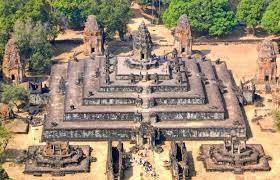Bakong Shiva Temple- Cambodia

Address
Bakong Shiva Temple, Hariharalaya, Roluos, Siem Reap Prasat Bakong, Cambodia
Diety
Shiva
Introduction
Bakong is the first temple mountain of sandstone constructed by rulers of the Khmer Empire at Angkor near modern Siem Reap in Cambodia. In the final decades of the 9th century AD, it served as the official state temple of King Indravarman I in the ancient city of Hariharalaya, located in an area that today is called Roluos. This temple complex is dedicated to Shiva. The structure of Bakong took shape of stepped pyramid, popularly identified as temple mountain of early Khmer temple architecture. The striking similarity of the Bakong and Borobudur temple in Java. The site of Bakong measures 900 metres by 700 metres, and consists of three concentric enclosures separated by two moats, the main axis going from east to west. The outer enclosure has neither a wall nor gopuram and its boundary is the outer moat, today only partially visible. The current access road from NH6 leads at the edge of the second enclosure. The inner moat delimits a 400 by 300 metres area, with remains of a laterite wall and four cruciform gopuram, and it is crossed by a wide earthen causeway, flanked by seven-headed nāgas, such as a draft of nāga bridge . Between the two moats there are the remains of 22 satellite temples of brick. The innermost enclosure, bounded by a laterite wall, measures 160 metres by 120 metres and contains the central temple pyramid and eight brick temple towers, two on each side. A number of other smaller buildings are also located within the enclosure. Just outside the eastern gopuram there is a modern Buddhist temple.
Puranic Significance
In 802 AD, the first king of Angkor Jayavarman II declared the sovereignty of Cambodia. After ups and downs, he established his capital at Hariharalaya. A few decades later, his successors constructed Bakong in stages, as the first temple mountain of sandstone at Angkor. The inscription on its stele (classified K.826) says that in 881 King Indravarman I dedicated the temple to the god Shiva and consecrated its central religious image, a lingam whose name Sri Indresvara was a combination of the king’s own and the suffix “esvara” which stood for Shiva. Bakong enjoyed its status as the state temple of Angkor for only a few years, but later additions from the 12th or 13th centuries testify that it was not abandoned. Toward the end of the 9th century, Indravarman’s son and successor Yasovarman I moved the capital from Hariharalaya to the area north of Siem Reap now known as Angkor, where he founded the new city of Yaśodharapura around a new temple mountain called Bakheng.
Century/Period/Age
9th century
Managed By
UNESCO World Heritage Centre.
Nearest Bus Station
Prasat Bakong
Nearest Railway Station
Sisophon Station
Nearest Airport
Siem Reap




